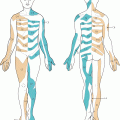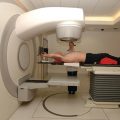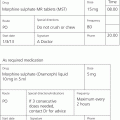Clinical trials
Research is an important part of oncology and a significant number of patients are enrolled into clinical trials. Trial methodology is evolving in order to try to shorten the time (and cost) involved in establishing if a drug is effective. However, in general, research can be categorised into the following phases:
- Preclinical: testing that is performed before the treatment is tried in humans.
- Phase I: aims to establish the dose and schedule of the experimental agent and to assess toxicity, i.e. ‘what dose should we use?’
- Usually single arm studies (i.e. all patients receive the same experimental agent).
- Usually involves small numbers of patients with a good performance status for whom there is no standard treatment option.
- Involves progressively increasing the dose of a drug in small cohorts of patients until the dose cannot be escalated any higher due to toxicity.
- Not designed to assess the efficacy of the drug and so only a small number of patients are expected to show any response (although this is improving with the development of targeted therapies).
- Phase II: aims to assess the activity, safety and feasibility of the new treatment, i.e. ‘does the treatment work and are the side effects tolerable?’
- May be a single arm study or involve randomisation of patients to the new treatment, the standard treatment or to a number of new treatments. The randomisation is not for statistical comparison of treatments, but rather to ensure that the patient population in each cohort is similar.
- Often open-label (and therefore not blinded).
- Phase III: aims to establish the efficacy and toxicity of a new treatment compared to an existing treatment (which might be observation/best supportive care if there is no current standard treatment), i.e. ‘Is the new treatment any better than our existing treatments?’
- Usually randomised in order to minimise bias.
- Usually involves large numbers of patients to ensure sufficient statistical power to detect differences in outcomes between treatments. This is very expensive and often involves multiple centres and international cooperation.
- Many newer drugs are molecularly targeted and involve screening patients for specific biomarkers that may be predictive of response. For targeted drugs, the number of patients in the trial may be lower.
- Phase IV: aims to learn more about toxicity and long-term risk-benefits. Post-marketing studies in oncology patients rather than within the context of a clinical trial.
All trials should be conducted according to good clinical practice (GCP). This is an international standard that aims to protect patient safety and confidentiality. Oncology research nurses and doctors need to undergo regular GCP training. All staff involved in a clinical trial should receive training regarding the trial and sign a delegation log, detailing their trial responsibilities. A doctor should not prescribe trial treatment for a patient unless they are on the delegation log.
Trial terminology
- Randomisation: patients are randomly allocated into different groups/arms. This can be done in a variety of different ways and aims to minimise the effects of potential confounding variables (e.g. age). Patients do not get a choice of which treatment they receive and unless the trial is a crossover trial there is no guarantee that they will receive the experimental treatment.
- Crossover: patients are switched to another treatment part way through the study.
- Blinding: helps to minimise bias. In double blind studies, neither the researchers nor the patients know what treatment the patient is receiving. In single blind studies, either the researchers or the patients (usually the researchers) know what treatment the patient is receiving.
- Open-label: both researchers and patients know what treatment is being administered.
- Placebo-controlled: one group of patients receives the active drug whereas another group receives an inactive substance (placebo).
- Protocol: the plan for the trial. This details the trial objectives, design and methodology and includes information such as trial eligibility and exclusion criteria and the schedule of treatments, tests, procedures and follow-up.
- Endpoint: an overall outcome that the study is designed to evaluate. Common endpoints include progression-free or overall survival.
Safety reporting
It is important to remember to inform the hospital research team of any untoward events that occur in patients who are on a clinical trial as they may need to be reported to the regulatory authorities (usually by the trial sponsor) within a specific time period. The sponsor may not be the hospital in which the trial is being conducted (e.g. a pharmaceutical company may be the trial sponsor). Therefore, adverse events/reactions need to be reported in a timely manner to the sponsor so that they can report the event to the regulatory authorities within the specified time limits.
There are a number of different types of adverse event/reactions:
- Adverse event (AE): any untoward medical occurrence encountered by a patient during the course of the trial. This can include the exacerbation of a pre-existing condition and is not necessarily related to the trial treatment.
- Serious adverse event (SAE): any AE that:
- Results in death
- Is life-threatening
- Requires in-patient hospitalisation or prolongation of existing hospitalisation
- Results in persistent or significant disability/incapacity
- Is a congenital abnormality/birth defect
- Is of medical importance
SAEs should be reported immediately to the trial sponsor unless they are specified in the trial protocol or in the Summary of Product Characteristics or the Investigator’s brochure as not requiring immediate reporting.
- Adverse reaction (AR): an AE where there is a reasonable possibility that the event may be related to the trial treatment (i.e. a relationship between the adverse event and the treatment cannot be ruled out).
- Serious Adverse Reaction (SAR): any SAE where there is a reasonable possibility that it has been caused by the study treatment. Some of these might be reasonably expected when taking into account the known side effects of the treatment or the likely cause of the patient’s disease.
SARs must be reported to the Medicines and Healthcare products Regulatory Agency (MHRA) and the relevant ethics committee as part of the annual safety report.
- Suspected Unexpected Serious Adverse Reaction (SUSAR): a SAR which was not expected from what was known about the trial treatment at that time.
SUSARs should be reported to the ethics committee and regulatory authorities according to specified timelines. In the UK, fatal and life-threatening SUSARs must be reported by the trial sponsor within seven days of awareness and within 15 days for other categories of SUSARs.







